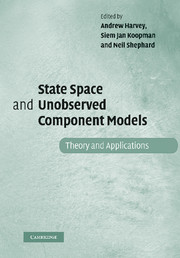Book contents
- Frontmatter
- Contents
- Preface
- Acknowledgements
- Part I State space models
- 1 Introduction to state space time series analysis
- 2 State structure, decision making and related issues
- 3 An introduction to particle filters
- Part II Testing
- Part III Bayesian inference and bootstrap
- Part IV Applications
- References
- Author index
- Subject index
2 - State structure, decision making and related issues
Published online by Cambridge University Press: 06 January 2010
- Frontmatter
- Contents
- Preface
- Acknowledgements
- Part I State space models
- 1 Introduction to state space time series analysis
- 2 State structure, decision making and related issues
- 3 An introduction to particle filters
- Part II Testing
- Part III Bayesian inference and bootstrap
- Part IV Applications
- References
- Author index
- Subject index
Summary
Abstract
The article explores the extended and strengthened role of state structure when statistical analysis is coupled with the optimisation of decisions. The LQG theory is of course well developed, with its explicit algorithms and complete formal duality of estimation and control. However, the path-integral formulation which is so natural for the state-structured case leads to an elegant formalism which is less well known. The risk-sensitive models give a mild but significant generalisation of the LQG case, with a complete theory and a special simplification in the state-structured case. The application of large-deviation methods, when these are applicable, leads to a direct but radical generalisation of the LQG theory.
State structure in time series analysis
Durbin and Koopman (2001) (and references quoted therein) have eloquently demonstrated the importance of the concept of state in time series analysis. If the underlying model has state structure then this greatly eases inference, but a central (and well-recognised) thesis of this paper is that it also eases decision-making. This enhanced role also requires an enhancement of the concept of state.
The simplest state-structured model is the first-order scalar linear autoregression
where the residuals (‘noise variables’) ∈ t are supposed NID(0, v). From this one obtains an immediate and simple evaluation of the quantity certainly required for inference: the likelihood based on the sample (x1, x2, …, xn).
- Type
- Chapter
- Information
- State Space and Unobserved Component ModelsTheory and Applications, pp. 26 - 39Publisher: Cambridge University PressPrint publication year: 2004



